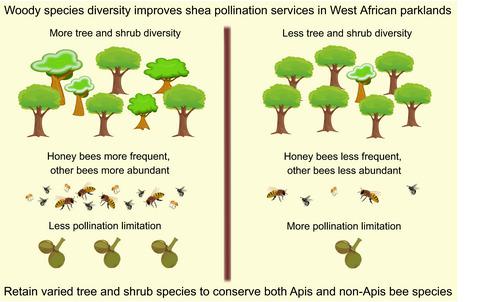当前位置:
X-MOL 学术
›
J. Appl. Ecol.
›
论文详情
Our official English website, www.x-mol.net, welcomes your feedback! (Note: you will need to create a separate account there.)
Local‐scale tree and shrub diversity improves pollination services to shea trees in tropical West African parklands
Journal of Applied Ecology ( IF 5.7 ) Pub Date : 2020-05-25 , DOI: 10.1111/1365-2664.13640 Aoife Delaney 1, 2, 3 , Assita Dembele 4 , Issa Nombré 5 , Franck Gnane Lirasse 6 , Elaine Marshall 7 , Adama Nana 4 , Juliet Vickery 2 , Catherine Tayleur 7, 8 , Jane C. Stout 1
中文翻译:

本地规模的树木和灌木多样性改善了西非热带雨林中乳木树的授粉服务
更新日期:2020-05-25
Journal of Applied Ecology ( IF 5.7 ) Pub Date : 2020-05-25 , DOI: 10.1111/1365-2664.13640 Aoife Delaney 1, 2, 3 , Assita Dembele 4 , Issa Nombré 5 , Franck Gnane Lirasse 6 , Elaine Marshall 7 , Adama Nana 4 , Juliet Vickery 2 , Catherine Tayleur 7, 8 , Jane C. Stout 1
Affiliation

|
- Shea Vitellaria paradoxa trees bear fruit and seeds of considerable economic, nutritional and cultural value in the African Sudano‐Sahelian zone. In much of West Africa, shea exists within an agroforestry system referred to as ‘parkland’, where social changes, including migration, have resulted in expanding areas of crop cultivation, reductions in both the area of fallow land and the duration of fallow periods, and reduced diversity of habitats and woody species. Shea benefits strongly from pollination by bees and the loss of Parkland biodiversity may reduce the availability of pollinators, leading to pollen limitation and reductions in fruit yields.
- We investigated whether shea trees in southern Burkina Faso experienced pollination limitation, and whether local‐ and landscape‐scale diversity were linked to visitation by bees, the degree of limitation observed and the weight of fruit produced.
- Honeybees Apis mellifera were observed more frequently in diverse sites, whereas non‐Apis species were generally widespread but visited trees in greater numbers at diverse sites.
- We found that shea fruit production was significantly limited due to lack of pollination and that the degree of pollination limitation was greater in sites with lower levels of tree and shrub diversity.
- Synthesis and applications. Sites with greater diversity of tree and shrub species had more bee visits and less extreme pollination limitation than less diverse sites, indicating that small‐scale diversity is associated with more efficient pollination services. Consequently, shea yields are likely to benefit from retention of a range of different tree and shrub species in parklands. We recommend that when fallows are cleared for cultivation, such beneficial plants are retained within cultivated fields, and that measures to conserve pollinators in the region should target both A. mellifera and non‐Apis bee species.
中文翻译:

本地规模的树木和灌木多样性改善了西非热带雨林中乳木树的授粉服务
- 非洲乳木果(Shea Vitellaria paradoxa)树在非洲Sudano-Sahelian区域结出了具有可观的经济,营养和文化价值的果实和种子。在西非的大部分地区,乳木果存在于被称为“公园地”的农林业系统中,那里的社会变化(包括移民)已导致农作物种植面积扩大,休耕地面积和休耕期减少,并减少了生境和木本物种的多样性。乳木果得益于蜜蜂的授粉,而帕克兰生物多样性的丧失可能会减少授粉媒介的可利用性,从而限制花粉并降低水果产量。
- 我们调查了布基纳法索南部的乳木果是否经历了授粉限制,以及当地和景观尺度的多样性是否与蜜蜂的造访,观察到的限制程度和所产果实的重量有关。
- 蜜蜂蜜蜂是在不同的地点观察到的更频繁,而非蜜蜂物种是在更大的数字一般普遍,但参观的树木在不同的网站。
- 我们发现,由于缺乏授粉,乳木果的产量受到极大限制,并且在树木和灌木多样性较低的地区,授粉限制的程度更大。
- 综合与应用。与物种较少的站点相比,树木和灌木物种多样性更大的站点有更多的蜜蜂来访,并且极端授粉的限制更少,这表明小规模的多样性与更有效的授粉服务相关。因此,乳木果的产量很可能受益于保留在公园中的各种不同树木和灌木物种。我们建议,当休耕的种植清除,这种有益的植物种植领域内保留,并采取措施以节省授粉在该地区应该同时针对西方蜜蜂和非蜜蜂蜂种。



























 京公网安备 11010802027423号
京公网安备 11010802027423号